Creating a stunning garden doesn’t have to drain your bank account or require a massive budget. We’ve discovered that some of the most beautiful outdoor spaces come from creative thinking and resourceful planning rather than expensive purchases. Whether you’re a beginner gardener or someone looking to refresh your existing space, affordable answers can transform any yard into a gorgeous retreat.
From repurposing household items into planters to starting plants from seeds instead of buying mature specimens, countless budget-friendly strategies exist. We’ll share practical techniques that maximize your gardening dollar while creating the lush industry you’ve been dreaming of.
The best part? Many of these cost-effective approaches actually produce better long-term results than their pricier alternatives. You’ll learn how to build healthy soil, create eye-catching displays, and maintain thriving plants without overspending. Let’s explore how smart choices and clever DIY answers can help you cultivate an amazing garden that looks like a million bucks.
Create a Thriving Vegetable Garden on a Shoestring Budget
Growing your own vegetables doesn’t require a massive investment or professional equipment. We can transform any small space into a productive food garden using simple strategies and recycled materials.
Start Seeds Indoors Using Recycled Containers
Yogurt cups, egg cartons, and plastic takeout containers make excellent seed starting vessels. We simply poke drainage holes in the bottom and fill them with potting soil to create perfect growing environments for tomatoes, peppers, and herbs.
Old newspaper becomes biodegradable seed pots when folded into small squares and secured with tape. These containers decompose naturally when transplanted directly into the garden, eliminating transplant shock for delicate seedlings.
Milk jugs transform into mini greenhouses by cutting off the top portion and leaving the handle attached. We place seed trays inside these protective covers during cold spring days, creating warm microclimates that extend our growing season by several weeks.
Choose High-Yield, Low-Cost Vegetables
Lettuce and spinach produce continuous harvests from a single planting when we pick outer leaves regularly. These leafy greens grow quickly in small spaces and cost just pennies per packet of seeds compared to $3-5 per store-bought container.
Beans and peas generate pounds of produce from minimal garden space while fixing nitrogen in the soil. We can harvest fresh pods for months from these climbing plants that require only basic support structures made from bamboo stakes or recycled wire fencing.
Radishes mature in just 30 days and help break up compacted soil for neighboring plants. These fast-growing vegetables allow us to maximize garden productivity by filling empty spaces between slower-growing crops like tomatoes and peppers.
Build Raised Beds with Free or Discounted Materials
Construction sites often discard untreated lumber scraps that work perfectly for raised bed frames. We contact local contractors or visit building supply stores to request these materials before they reach the dumpster.
Concrete blocks from demolished structures create durable raised bed walls without tools or hardware. These heavy materials provide excellent drainage and thermal mass while costing significantly less than new cedar boards or composite materials.
Fallen logs and thick branches form natural raised bed borders that blend seamlessly into industry designs. We collect these materials from storm cleanup sites or ask tree service companies for branches they would otherwise chip or dispose of.
Transform Your Space with DIY Garden Containers and Planters
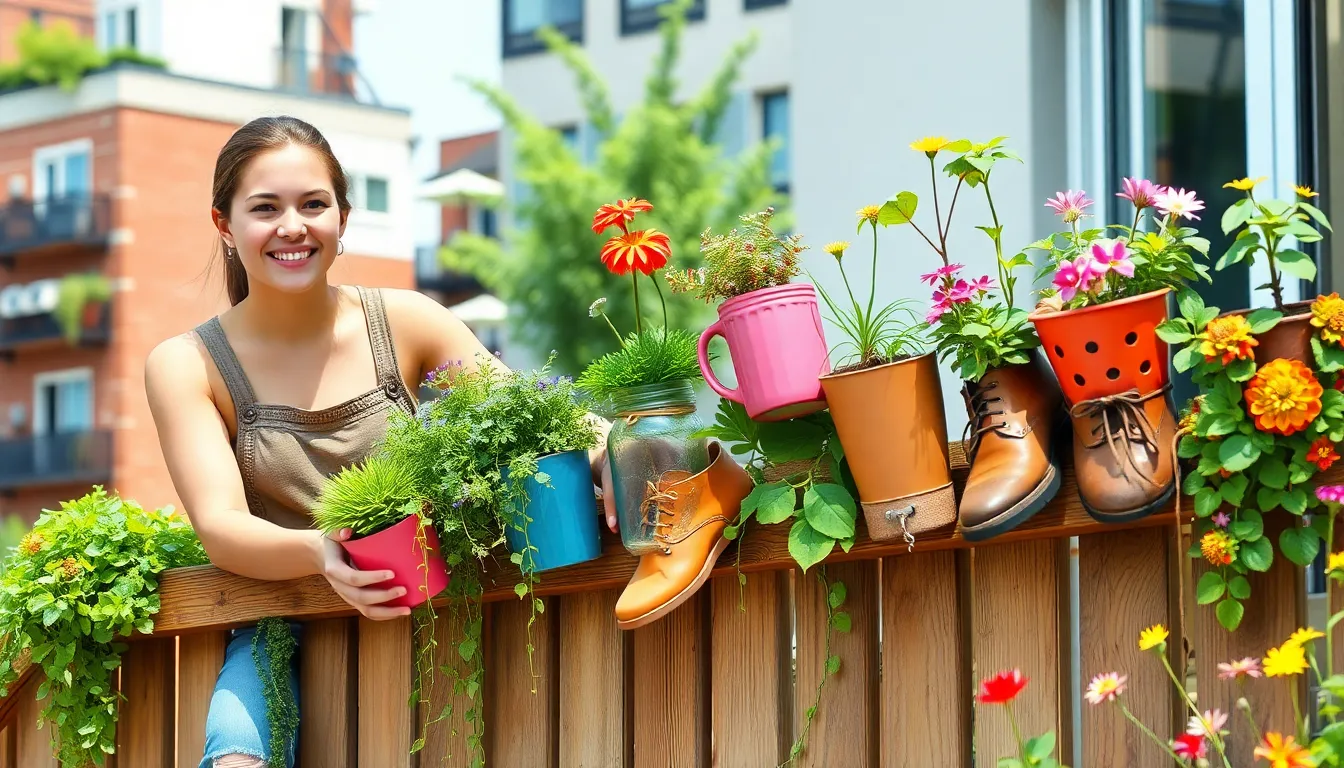
Container gardening opens up countless opportunities for creative expression while keeping costs minimal. We’ve discovered that transforming everyday items into planters delivers both functionality and unique aesthetic appeal.
Repurpose Household Items as Unique Planters
Teacups make charming homes for small succulents and herbs, creating whimsical displays on windowsills or outdoor tables. Mason jars work perfectly for propagating cuttings or growing microgreens, and their clear glass lets us monitor root development. Coffee cans transform into excellent planters for medium-sized plants like tomatoes or peppers with proper drainage holes added.
Old shoes become conversation starters when filled with trailing plants or colorful flowers, adding personality to garden spaces. Decorative tins and empty food containers offer sturdy alternatives that cost nothing extra from our kitchen recycling. These repurposed household items reduce waste while providing eclectic visual interest that traditional planters can’t match.
Build Wooden Planters from Scrap Materials
Scrap wood from old pallets creates sturdy raised planter beds that customize to fit any available space. Western red cedar offers natural rot resistance, making it an ideal choice for long-lasting garden containers. Leftover lumber from construction projects works perfectly for building raised beds without requiring expensive materials purchases.
Untreated scrap materials assemble easily into functional planters that don’t need complex woodworking skills. Raised beds eliminate the need for tilling existing soil and provide better drainage control for healthier plants. These wooden containers work exceptionally well on patios, balconies, or small backyards where traditional gardening isn’t possible.
Create Hanging Gardens with Budget-Friendly Supplies
Macramé hangers support lightweight containers while adding bohemian charm to vertical garden displays. Woven baskets work beautifully for trailing plants and herbs, creating natural-looking suspended gardens that maximize growing space. Repurposed containers with added hanging mechanisms transform into space-efficient planters for small areas.
Wall-mounted containers provide easy access for watering and maintenance while keeping plants at eye level for daily care. Quick hanging hoop planters create flexible arrangements that we can move seasonally or rearrange for optimal light exposure. These vertical answers make the most of limited space while adding dimensional interest to garden areas.
Design Beautiful Garden Paths and Borders Without Breaking the Bank
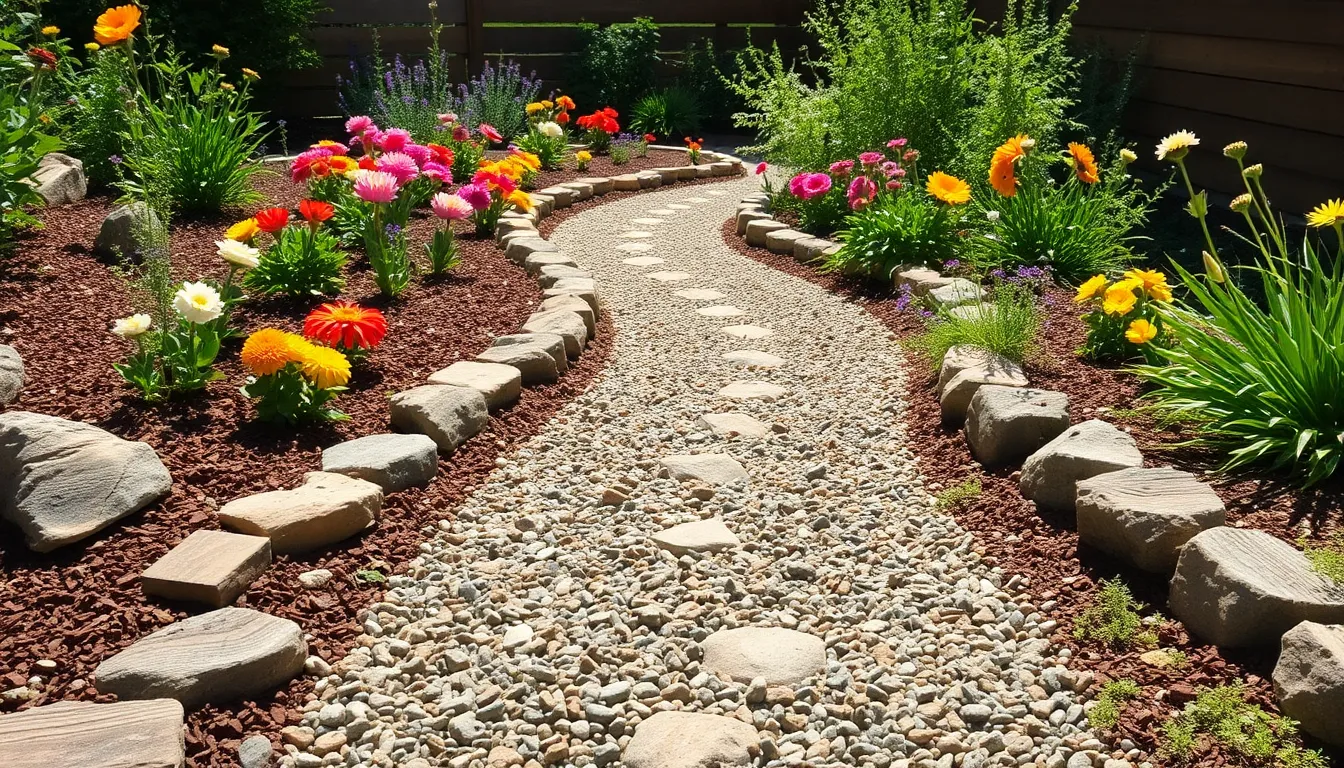
Creating stunning walkways and defined garden spaces doesn’t require expensive materials when you know where to look for affordable alternatives.
Use Gravel and Mulch for Affordable Walkways
Gravel provides excellent drainage while creating attractive pathways that cost significantly less than traditional paving materials. We can source gravel affordably from local suppliers or construction sites, making it one of the most budget-friendly options for garden walkways. Mulch adds a decorative element to paths while helping retain moisture in surrounding soil areas.
Both materials offer practical benefits beyond their low cost. Gravel requires minimal maintenance once installed and naturally prevents weed growth in high-traffic areas. Mulch paths blend seamlessly with planted areas and can be refreshed annually with free materials from municipal composting programs.
Create Natural Stone Borders with Found Materials
Natural stones collected from your own yard or nearby areas provide free materials for creating attractive garden borders. We recommend gathering stones during walks, yard cleanup projects, or with permission from construction sites where they’re often discarded. Arranging these found stones creates character-rich borders that add visual definition to garden beds.
Collected stones work particularly well for informal garden designs where perfectly uniform borders aren’t necessary. Different sizes and shapes create interesting textures that complement plantings while requiring zero material costs. These natural borders also improve drainage around garden beds compared to solid manufactured edging materials.
Install Simple Edging with Recycled Items
Recycled materials like old bricks, plastic bottles, and wooden planks transform into unique garden edging that saves money while adding creative flair. Old bricks can be arranged in various patterns to create formal or casual border styles depending on your garden’s aesthetic. Plastic bottles buried halfway into the ground create colorful, child-friendly edging that’s perfect for vegetable gardens.
Wooden planks from construction scraps or old fencing provide sturdy edging that contains mulch and defines planting areas effectively. We’ve found that combining different recycled materials creates eclectic borders that become conversation pieces while keeping garden enhancement costs near zero.
Establish Low-Maintenance Ground Cover and Landscaping
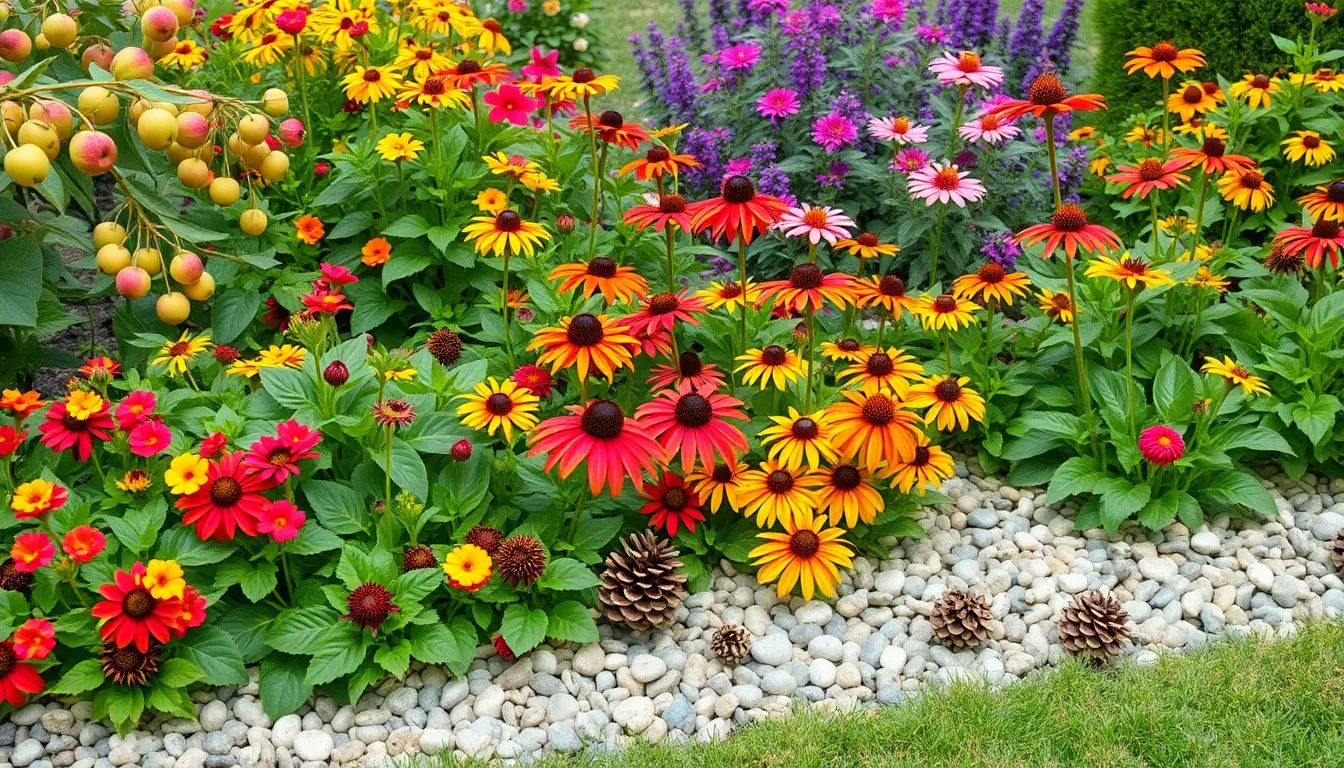
Ground cover plants and smart landscaping choices reduce our garden maintenance while keeping costs minimal. Smart plant selection eliminates the need for constant watering, fertilizing, and replanting.
Plant Native Species That Thrive Naturally
Native plants offer the most cost-effective landscaping solution because they’re naturally adapted to our local climate and soil conditions. Crab apples and ornamental cherries provide beautiful seasonal displays without requiring special care or expensive amendments. These species support local ecosystems by attracting beneficial insects and birds that naturally control garden pests.
Local nurseries often sell native plants at lower prices than exotic varieties since they’re easier to propagate and maintain. We can reduce our water bills significantly by choosing plants that survive on natural rainfall after their first growing season. Native wildflowers like black-eyed Susan and purple coneflower spread naturally to fill empty spaces without additional purchases.
Use Mulch and Compost to Suppress Weeds
Decorative mulch materials like pebbles, shells, and pine cones conserve soil moisture while preventing weed growth naturally. These materials cost far less than commercial herbicides and provide long-term benefits that save money over multiple growing seasons. Organic mulches break down slowly to improve soil structure without expensive fertilizer applications.
Compost enriches garden soil with essential nutrients while eliminating the need for costly commercial amendments. We can create compost from kitchen scraps and yard waste at no additional cost to our household budget. Apply a 2-3 inch layer of compost around plants to suppress weeds and retain moisture during dry periods.
Create Zones with Perennial Plants
Perennial plants like daylilies and coneflowers return year after year, eliminating annual replanting costs that drain garden budgets. These hardy plants establish strong root systems that require minimal watering once established in our industry design. Dividing mature perennials every few years provides free plants to expand garden zones without purchasing new stock.
Zone planning with perennials creates distinct garden areas that serve different purposes while maintaining visual cohesion throughout the space. We can group plants with similar water and sunlight needs to reduce maintenance time and ensure optimal growing conditions. Strategic placement of spreading perennials fills large areas quickly, reducing the number of individual plants we need to purchase initially.
Build Essential Garden Structures for Less
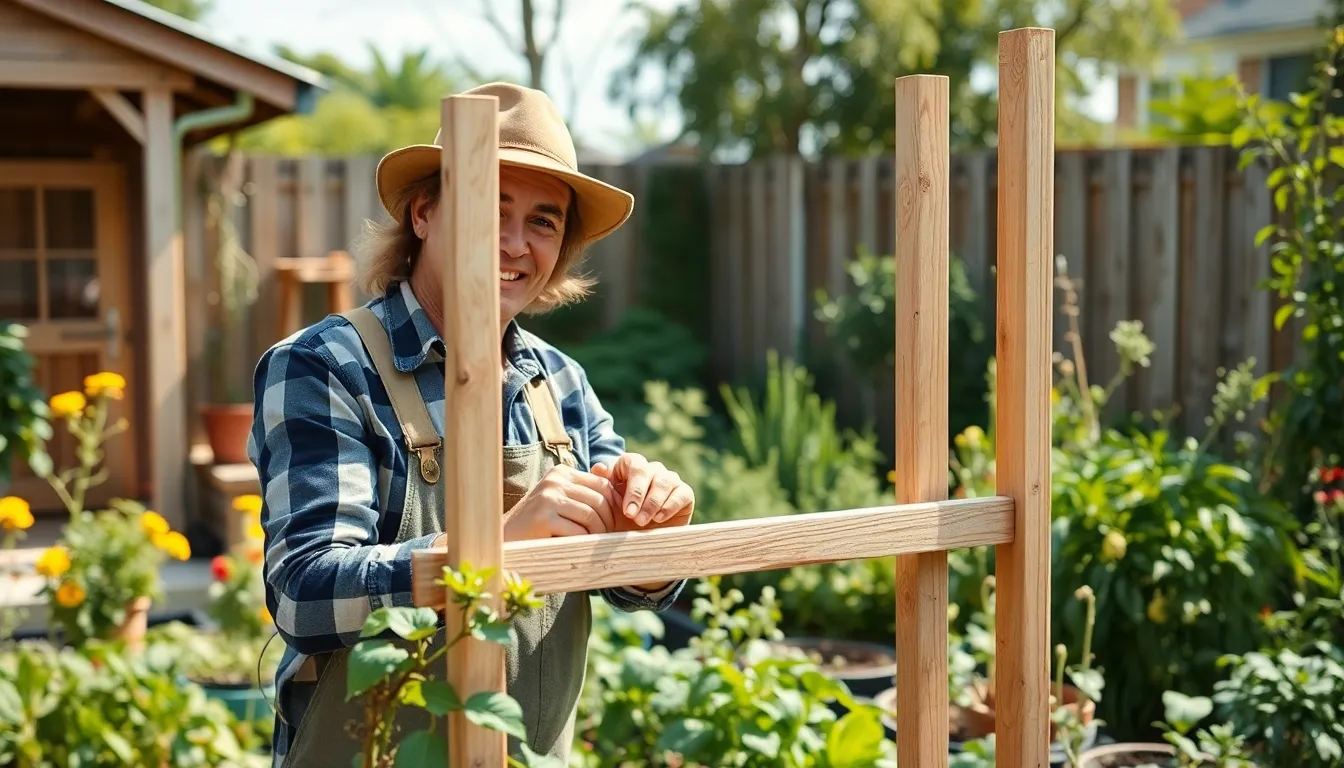
Building functional garden structures doesn’t require expensive materials or professional skills. We can transform common items and salvaged materials into essential garden infrastructure that rivals store bought alternatives.
Construct Simple Trellises and Support Systems
Make freestanding trellises using wooden sticks, bamboo poles, or old metal rods connected with screws or twine to support climbing plants like tomatoes and beans. These materials cost significantly less than commercial trellises while providing the same structural support for your vegetables.
Build collapsible supports by creating ladder-like structures with hinges for easy storage and adjustable support for tall plants. We recommend constructing these from scrap wood or repurposed materials to keep costs minimal while ensuring your plants receive proper vertical support throughout the growing season.
Add string or netting by installing eyelets into wood or metal frames to weave twine or netting for plants to climb. This approach works particularly well for peas, cucumbers, and flowering vines that need guidance as they grow upward.
Create Shade Structures with Basic Materials
Use shade cloth by draping it or old fabric over wooden stakes to protect sensitive plants from harsh sun. This method provides crucial protection for delicate seedlings and heat-sensitive vegetables without investing in expensive permanent structures.
Build simple pergolas using salvaged wood or bamboo to construct lightweight pergolas or arbors for decorative shade. These structures not only protect plants but also create attractive focal points in your garden while utilizing materials that might otherwise go to waste.
Install Basic Irrigation Systems on a Budget
Reuse household items like repurposed bottles or jugs with small holes as slow-release watering devices. These DIY systems deliver consistent moisture to plant roots while reducing water waste and maintenance time.
Create drip irrigation by attaching a length of perforated hose to a water source for targeted, low-cost irrigation. This system ensures water reaches exactly where plants need it most while conserving water compared to traditional sprinkler methods.
Use soaker hoses by placing inexpensive soaker hoses around plant beds to deliver water directly to roots. This efficient watering method reduces evaporation and prevents water from reaching weeds between your desired plants.
Maximize Your Garden’s Potential with Smart Plant Choices
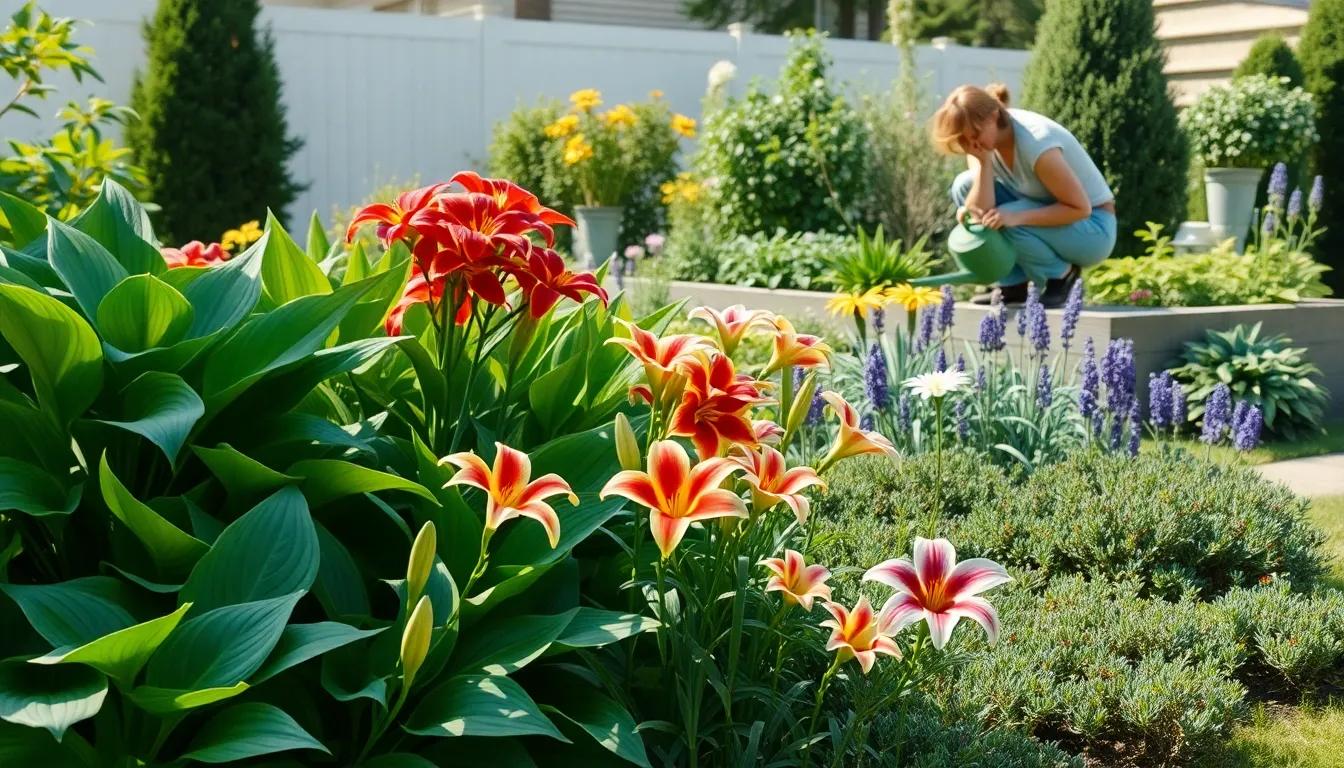
Strategic plant selection transforms your garden into a thriving network that works harder for your budget. Smart choices multiply your investment while reducing ongoing maintenance costs.
Select Plants That Multiply and Spread Naturally
Hostas offer exceptional value as they expand their coverage year after year without additional investment. These shade loving perennials divide easily and can fill entire garden areas over just a few seasons.
Daylilies provide stunning blooms while naturally multiplying through underground root systems. We recommend starting with just a few plants since they’ll create substantial clusters within three growing seasons.
Creeping thyme serves as an excellent ground cover that spreads naturally to fill gaps between stepping stones and borders. This low maintenance option requires minimal care once established and provides fragrant purple flowers throughout summer.
| Plant Type | Spread Rate | Coverage Area | Years to Full Coverage |
|---|---|---|---|
| Hostas | Moderate | 3-4 feet | 3-4 years |
| Daylilies | Fast | 2-3 feet | 2-3 years |
| Creeping Thyme | Fast | 12-18 inches | 1-2 years |
Choose Drought Tolerant Varieties to Save on Water
Succulents like aloe and agave thrive in dry conditions while adding architectural interest to garden designs. These water efficient plants store moisture in their leaves and require watering only once weekly during growing season.
Native grasses adapt perfectly to local rainfall patterns and eliminate the need for supplemental irrigation systems. Regional varieties like buffalo grass or blue grama naturally withstand drought conditions while providing movement and texture.
Lavender combines water efficiency with practical benefits as it produces fragrant oils and attracts beneficial pollinators. We’ve found that established lavender plants survive on rainfall alone in most climates.
Mediterranean herbs including rosemary and oregano flourish in dry conditions while providing fresh ingredients for cooking. These dual purpose plants reduce water consumption by up to 60% compared to traditional garden varieties.
Grow Plants That Serve Multiple Purposes
Rosemary functions as an attractive evergreen shrub while supplying fresh herbs for culinary use year round. This versatile plant also repels garden pests naturally and requires minimal maintenance once established.
Lavender provides three distinct benefits: ornamental purple flowers, aromatic foliage for crafts, and natural pest deterrent properties. We appreciate how this single plant investment delivers multiple returns throughout the growing season.
Fruit bearing shrubs like blueberry bushes offer spring flowers, summer fruit harvests, and brilliant fall foliage colors. These productive plants justify their initial cost through years of fresh produce while improving industry beauty.
Edible flowers such as nasturtiums brighten garden beds while providing peppery leaves and blooms for salads. These climbing varieties also attract beneficial insects and can cover unsightly fence areas naturally.
Maintain Your Garden Economically Throughout the Seasons
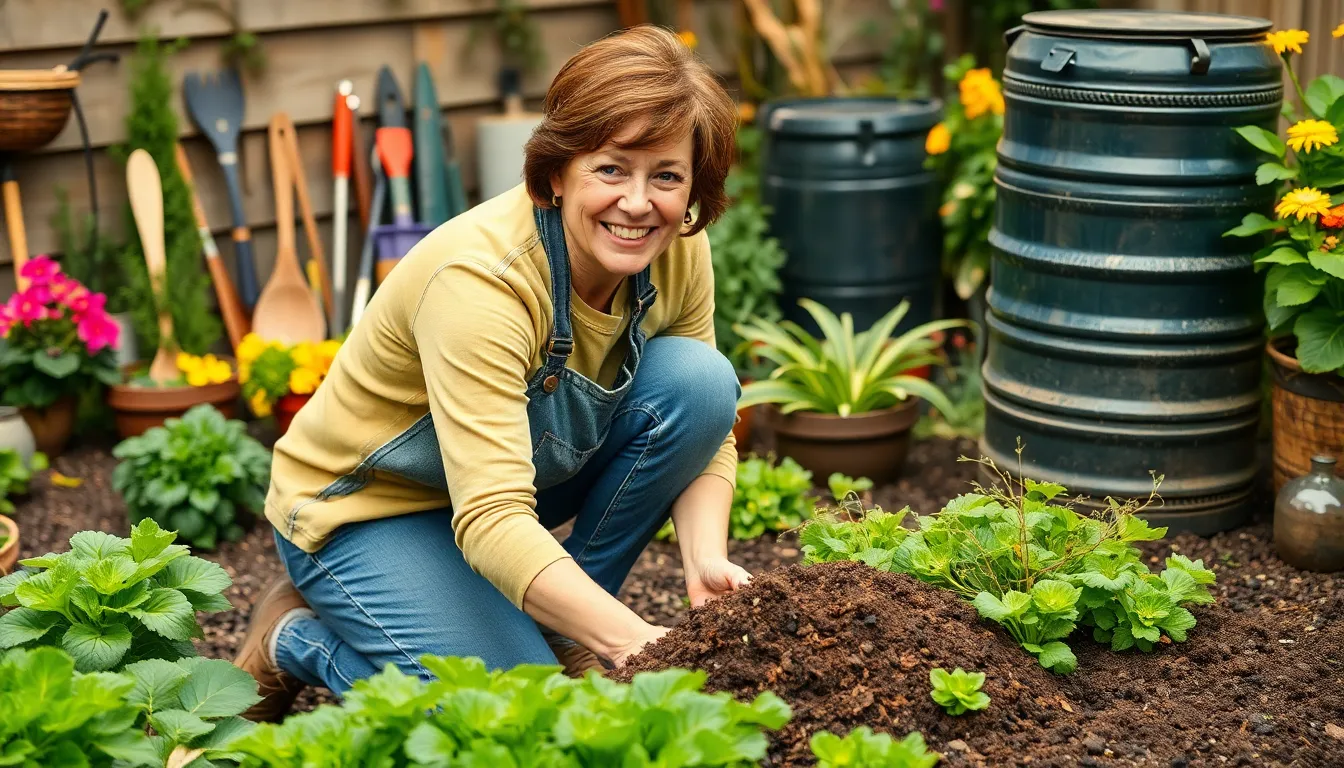
Year round garden maintenance doesn’t have to drain our wallets when we adopt strategic seasonal approaches. We’ll explore proven methods that keep our gardens thriving while minimizing expenses through every growing season.
Make Your Own Organic Fertilizers and Pesticides
Composting transforms our kitchen scraps and yard waste into nutrient rich soil amendments without any purchase costs. We can create effective compost using vegetable peels, coffee grounds, eggshells, and fallen leaves to feed our plants naturally.
Manure tea provides powerful liquid fertilization by steeping animal manure in water for 24 to 48 hours. This homemade fertilizer delivers essential nutrients directly to plant roots at a fraction of commercial fertilizer costs.
Natural pest control becomes affordable when we use neem oil as our primary organic pesticide solution. Neem oil effectively manages aphids, spider mites, and other common garden pests while remaining safe for beneficial insects and our families.
Companion planting reduces our need for expensive pest control products by using plants that naturally repel harmful insects. Marigolds deter nematodes and aphids, while basil planted near tomatoes improves flavor and keeps pests away.
Carry out Water-Saving Techniques and Rain Collection
Rain barrels capture free water from our roof gutters, reducing monthly water bills while providing chlorine free irrigation for our plants. A single inch of rainfall on a 1000 square foot roof yields approximately 600 gallons of collectible water.
Drip irrigation systems deliver water directly to plant roots, reducing water usage by up to 50% compared to traditional sprinkler methods. We can build simple drip systems using plastic bottles with small holes or purchasing affordable drip irrigation kits.
Mulching strategies retain soil moisture by reducing evaporation, cutting our watering needs significantly during hot summer months. Organic mulches like grass clippings, shredded leaves, and wood chips also decompose to improve soil quality over time.
Practice Seasonal Care That Prevents Costly Problems
Strategic seasonal planting eliminates expensive heating or cooling measures by choosing appropriate varieties for each growing period. Cool season crops like lettuce and peas thrive in spring and fall, while warm season plants like tomatoes and peppers excel during summer months.
Regular pruning schedules maintain plant health and prevent diseases that could require costly treatments or plant replacement. We should prune fruit trees during dormancy, deadhead flowers throughout growing season, and remove damaged branches immediately.
Proactive weed control prevents competition for water and nutrients that would otherwise require additional fertilization and irrigation. Hand pulling weeds after rain events when soil is soft saves time and eliminates the need for expensive herbicides.
Disease prevention through proper spacing and air circulation reduces our reliance on fungicides and plant replacements. We can prevent most fungal issues by watering at soil level rather than on leaves and ensuring adequate spacing between plants.
Conclusion
Creating a stunning garden doesn’t require a massive budget or professional expertise. We’ve shown you that with creativity resourcefulness and smart planning you can transform any outdoor space into a thriving oasis.
From repurposing household items as planters to building your own garden structures these budget-friendly approaches often deliver better long-term results than expensive alternatives. You’ll develop valuable skills while saving money and creating something uniquely yours.
The key is starting small and building gradually. Choose projects that match your skill level and available time then expand as your confidence grows. Remember that the most beautiful gardens aren’t always the most expensive ones – they’re the ones filled with creativity care and personal touches that reflect your unique style.
Frequently Asked Questions
Can I really create a beautiful garden without spending a lot of money?
Absolutely! You can create stunning outdoor spaces through creativity and resourcefulness rather than expensive purchases. By repurposing household items, starting plants from seeds, and using DIY solutions, you can achieve beautiful results while building valuable gardening skills and saving money long-term.
What household items can I repurpose as planters?
Many everyday items make excellent planters, including yogurt cups, egg cartons, mason jars, old shoes, and teacups. You can also create biodegradable seed pots from old newspapers and transform milk jugs into mini greenhouses to extend your growing season.
Which vegetables give the best value for budget gardening?
High-yield, low-cost vegetables like lettuce, beans, and radishes are perfect for budget gardening. These crops grow quickly, produce abundantly in small spaces, and provide excellent returns on your minimal investment while being easy to grow from inexpensive seeds.
How can I build raised beds cheaply?
You can build affordable raised beds using free or discounted materials like untreated lumber scraps from construction sites, old pallets, concrete blocks from demolished structures, or even repurposed wooden planks. These materials create effective garden structures without the high cost of new lumber.
What are the best low-maintenance plants for budget gardens?
Native species like crab apples and ornamental cherries are ideal because they thrive naturally in local climates with minimal care. Drought-tolerant plants like succulents and native grasses save on water costs, while perennials return year after year, reducing replanting expenses.
How do I create garden paths and borders on a budget?
Use gravel and mulch for affordable walkways that provide excellent drainage and low maintenance. Create natural stone borders with found materials, or install edging with recycled items like old bricks, plastic bottles, and wooden planks for unique, cost-effective garden borders.
What DIY garden structures can I build myself?
You can construct simple trellises using wooden sticks, bamboo poles, or old metal rods for climbing plants. Create shade structures with shade cloth or salvaged wood, and build budget-friendly irrigation systems by repurposing bottles for slow-release watering or using soaker hoses.
How can I maintain my garden economically year-round?
Create homemade organic fertilizers by composting kitchen scraps and making manure tea. Use natural pest control methods like neem oil and companion planting. Implement water-saving techniques such as rain collection and drip irrigation, plus practice regular pruning to prevent costly problems.







